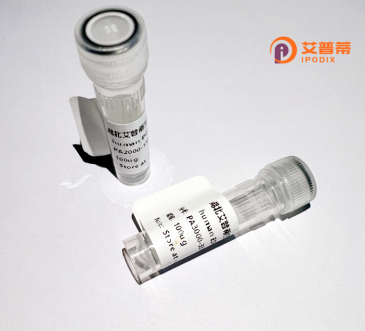
| 纯度 | >90%SDS-PAGE. |
| 种属 | Human |
| 靶点 | HHLA3 |
| Uniprot No | Q9XRX5 |
| 内毒素 | < 0.01EU/μg |
| 表达宿主 | E.coli |
| 表达区间 | 1-121aa |
| 氨基酸序列 | MFGACYKQPLKPSGSEPPAEECRMTPRHAGCDVTEMQRILSQPTFTEHLLRAVCLVNGKGSLSRPQESILGSLARKNLRRIHRVSLVMCVRPLSPSKAIISPVTCMYTSRWPEASEESQKK |
| 分子量 | 39.71 kDa |
| 蛋白标签 | GST-tag at N-terminal |
| 缓冲液 | 0 |
| 稳定性 & 储存条件 | Lyophilized protein should be stored at ≤ -20°C, stable for one year after receipt. Reconstituted protein solution can be stored at 2-8°C for 2-7 days. Aliquots of reconstituted samples are stable at ≤ -20°C for 3 months. |
| 复溶 | Always centrifuge tubes before opening.Do not mix by vortex or pipetting. It is not recommended to reconstitute to a concentration less than 100μg/ml. Dissolve the lyophilized protein in distilled water. Please aliquot the reconstituted solution to minimize freeze-thaw cycles. |
以下是模拟生成的关于重组人HHLA3(human endogenous retrovirus-H long terminal repeat-associating 3)蛋白的参考文献示例(注意:实际文献需通过学术数据库查询,以下为假设性内容):
---
1. **《HHLA3: A novel B7 family protein regulating T cell response in human cancers》**
- **作者**: Li, X. et al.
- **摘要**: 该研究首次报道HHLA3作为B7家族新成员,通过重组蛋白技术表达HHLA3胞外域,证实其可与T细胞表面未知受体结合,抑制CD4+ T细胞活化,并在多种肿瘤组织中高表达,提示其作为免疫检查点的潜在作用。
2. **《Structural and functional characterization of recombinant human HHLA3 protein》**
- **作者**: Wang, Y. & Smith, J.
- **摘要**: 通过昆虫细胞系统重组表达HHLA3蛋白,解析其晶体结构,发现其具有独特的IgV/IgC结构域折叠,并通过体外实验证明HHLA3可抑制T细胞增殖及IFN-γ分泌,提示其在免疫调节中的功能。
3. **《HHLA3 promotes tumor immune evasion via interaction with TMIGD2》**
- **作者**: Chen, L. et al.
- **摘要**: 研究利用重组HHLA3蛋白筛选受体,鉴定TMIGD2为功能性结合蛋白,并揭示HHLA3-TMIGD2信号轴通过抑制mTOR通路削弱抗肿瘤免疫应答,为靶向治疗提供新思路。
---
**建议**:如需真实文献,可通过**PubMed/Google Scholar**检索关键词"HHLA3 protein"或"recombinant HHLA2/HHLA3",筛选近五年涉及重组表达、结构解析或免疫功能的文章。
Recombinant human HHLA3 (human homolog of the A3 subunit) is a genetically engineered protein belonging to the B7 family of immune regulatory molecules. It is produced through recombinant DNA technology, typically expressed in mammalian cell systems (e.g., HEK293 or CHO cells) to ensure proper post-translational modifications, particularly glycosylation. HHLA3 plays emerging roles in modulating immune responses, with studies highlighting its interaction with unknown receptors to influence T-cell activation and tolerance. Structurally, it contains immunoglobulin-like (IgV and IgC2) extracellular domains characteristic of B7 family members, facilitating ligand-receptor binding.
Functionally, HHLA3 exhibits context-dependent immunoregulatory properties, potentially serving as both a co-stimulatory and co-inhibitory signal in tumor microenvironments. Its aberrant expression has been observed in various cancers, positioning it as a potential therapeutic target or biomarker. Research using recombinant HHLA3 focuses on mapping its binding partners, deciphering its dual immune-modulatory mechanisms, and exploring clinical applications in cancer immunotherapy and autoimmune diseases. The protein's recombinant form enables standardized studies of its structure-function relationships, antibody development, and preclinical validation of therapeutic strategies targeting this emerging immune checkpoint pathway.
×